Pill bugs are one of the best-known little pests due to their armadillo-like defense mechanism. Unfortunately, they can be known by one of several different names depending on your location, and all of them are actually misnomers.
Regardless of what you call them, they’re an interesting little critter that has a habit of invading your home. Here’s how to get rid of pill bugs…
Identifying Pill Bugs
Pill bugs are a small, armored critter that looks more like a cross between a trilobite and armadillo. They’re really easy to spot, although it’s easy to get them confused with pill millipedes. As these two critters have a convergent evolution (meaning they evolved separately with a similar end result), we’ll be lumping the two together for much of this discussion.
Related: How to Get Rid of Millipedes
A Bug by Any Other Name
Depending upon where you live, this bug and its similar counterpart, the pill millipede, can have one or over 20 different nicknames. While the pill bug and sow bug (pill millipede) are only distant cousins, their similarity means you’ll probably not know which you have until you’re up close
Pill Bug
Perhaps the second most common name for this critter, it’s in reference to the slightly squashed look when the pill bug rolls into a ball. To this day, some pills have a similar shape.
Potato Bug
The most common name, especially on the East Coast, these critters have gained this name due to their habit of infesting potato plants.
Roly-Poly/Rollie Pollie
Besides being fun to say, this name is a direct reference to the bug’s ability to roll into a ball.
Wood Louse
This is actually a name that gets around quite a bit, and is again related to the bug’s habit of living near a cool, damp food source.
Other names
Between the two species, there are a number of names found worldwide. These additional names include:
Boat-Builders
Butchy Boys
Carpenters
Cheese Logs
Chisel Bobs
Chuggie Pigs
Chuggy-Pegs
Crunchy Bats
Doodle Bugs
Granny Greys
Gramfers
Monkey Peas
Parson Pigs
Peaballs
Slaters
Tomato Bugs
Wood Bugs
Wood Pigs
Basic Biology
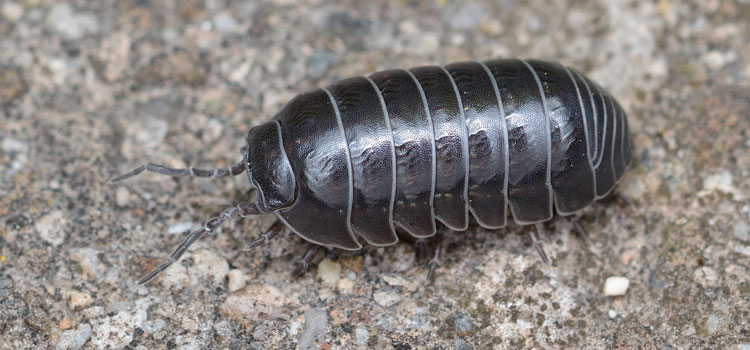
Being arthropods, pill bugs have a lot of biological features that are difficult to spot. The most obvious is their oblong, segmented body. Most often grey in color, the plates may also appear brown, white (after hatching), and pinkish (during molting).
Their underside is whitish, with several pairs of legs. They also have two long, thick antennae which have segments that make them look like additional legs.
Speaking of legs, they have smaller appendages under their shell which resemble legs but are actually used for breathing, grabbing water, and mating.
See Also: Shrimp and Roaches (Are They Related?)
Pill Bug vs Sow Bug Biology
The biology of these two critters can be so similar that you often won’t know which you have until you’re very close. Pill millipedes (sow bugs) have a flatter body and cannot roll into a ball. They also have an appendage somewhat resembling a tail and coloration a little closer to that of millipedes.
One other major difference is in the legs. Pill bugs have up to 7 pairs of legs, or one per segment. Pill millipedes, conversely, have two pairs per segment.
What Do Rollie Pollie Bugs Eat?
These little guys are an important part of the environment and feed off of dead plant matter. This is why woodlice can often be found in rotting trees.
They’ve earned the nicknames “potato bugs” and “tomato bugs” because they’ll sometimes go after healthy crop foods, although these are most often young plant shoots.
Identifying Pill Bug Infestations
Pill bugs can be a nuisance when they infest your garden, greenhouse, or home. To identify a pill bug infestation, the best thing to do is to keep an eye out for these critters around your property, especially in moist, dark areas.
In your garden and around your seedlings, pay close attention to the soil and roots of your plants. If you notice pill bugs congregating in significant numbers or see them feeding on tender green shoots, then it’s likely you have an infestation. Additionally, examine the soil and the base of your plants for any signs of damage caused by these pests.
Foundations and other structures near your garden or home also provide ideal habitats for pill bugs. Regularly inspect these areas for their presence, especially if they’re damp or have decaying materials nearby.
Moist environments like basements, crawlspaces, and greenhouses may also contain pill bug infestations since they prefer high humidity levels.
Getting Rid of Pill Bugs
As a general rule, pill bugs are harmless and help aerate the soil. They’re also edible, but I wouldn’t recommend this, as they taste terrible. However, if you see these little guys munching on young garden plants or invading your home, then steps need to be taken.
In the House
The most frequent place you’ll find roly polies invading your home is in the basement. The cool, damp atmosphere is perfect for their needs, and they love the darkness. Simply using a dehumidifier is sometimes enough to get them out of a finished basements.
Finding a pill bug in your home can be an important early warning sign of water damage. As they require moisture to survive, spotting an infestation of pill bugs near pipes or portions of wall can be an indication that repairs are needed. Once the source of moisture is gone, the pill bugs will soon follow.
Note that you will need to not only remove the source of moisture, but also seal any nearby cracks or entry points. The pill bugs themselves can simply be vacuumed up, but so long as there’s a hospitable space (especially in the autumn when these critters are looking for a warmer residence), there’s always a risk of reinfestation.
In the Garden
As already mentioned, pill bugs can be highly beneficial to your garden. They make compost, aerate the soil, and have enough predators that they’ll rarely overpopulate any outdoor space. The downside is that they’ll sometimes snack on young shoots and berries, giving the signal that an eviction is needed.
When eliminating pill bugs from your garden, you should always think of it as as form of population control and not an outright extermination. These critters are necessary for your garden to remain healthy, so never try to completely eradicate them.
Some people use salt to try and dry out the pill bug (as they do with ants), although this isn’t very effective and could harm your plants. A more positive weapon is Diatomaceous Earth, which is relatively safe for humans and larger pets, but will kill insects and other bugs which walk over it.
Other critters such as frogs and lizards love to eat small bugs and pill bugs are no exception. So get yourself a couple of these to control the rollie pollie infestation but then you may have other critters to worry about.
You can check the trap once per day up to once per week. Remove any pill bugs you find in the cavity, as well as a handful of the dirt under the trap. You can reuse the trap and dispose of your “captured” critters.
Incidentally, cantaloupe rinds can also be used instead of potatoes.
Does Vinegar Kill Pills Bugs?
No, vinegar cannot kill pill bugs. While vinegar can be used as a pesticide to eliminate certain types of insects, there is no evidence to suggest that vinegar can kill pill bugs due to it not being potent enough to penetrate the pill bug’s shell-like exoskeleton.
In fact, pill bugs are known to be resistant to many types of pesticides. Vinegar can, however, be used as a natural cleaning agent and disinfectant.
Preventing a Future Pill Bug Infestation
Maintain a Healthy Garden Environment
A healthy garden environment is one of the best ways to prevent pill bug infestations. By reducing the damp and dark hiding places they love, you can minimize their presence in your garden.
Things you can do:
- Remove decaying plant matter, such as mulch and leaves, to eliminate their breeding grounds.
- Maintain a 1 to 2-foot buffer between your home’s foundation and any landscape plantings.
- Keep firewood off the ground and away from your home.
- Store garden tools and flower pots off the ground.
Seal Entry Points
It’s equally important to seal any entry points in your home that might invite pill bugs indoors.
- Check for gaps or cracks around doors and windows, and apply weather-stripping where needed.
- Seal openings, such as vents, with caulk to keep pill bugs out.
- Regularly inspect your home’s exterior for any signs of damage or entry points, and make repairs as needed.
Improve Ventilation
Because of their love for damp places, making sure you have proper ventilation is important. Here are some things you can do to help with that:
- Install a dehumidifier in damp areas, such as basements, crawlspaces, or attics, to help control humidity levels.
- Use fans or other air-circulation devices to keep the air moving and minimize dampness.
- Store paper, cardboard, and other organic matter off the floor to avoid attracting pill bugs.
- How to Get Rid of Hawks - March 8, 2024
- How to Get Rid of Pill Bugs (Rolly Pollies) - March 1, 2024
- How to Get Rid of Groundhogs (Woodchucks) - February 5, 2024

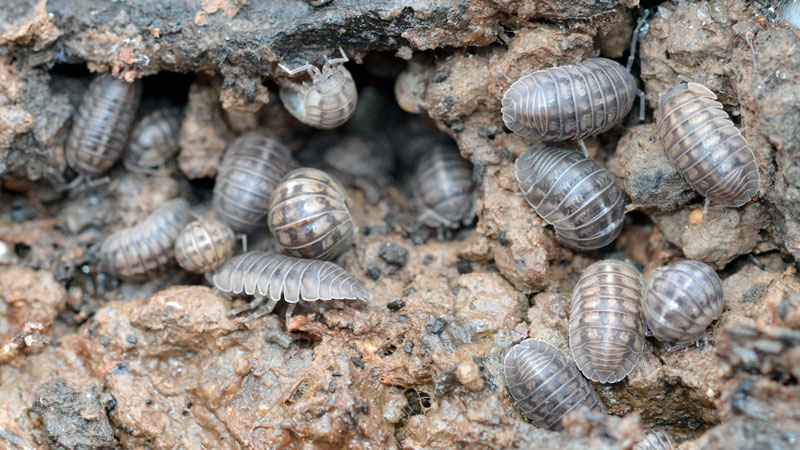

 Just tell me how to get rid of ’em.
Just tell me how to get rid of ’em.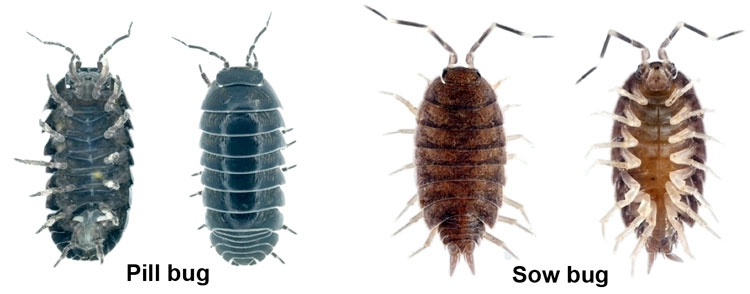
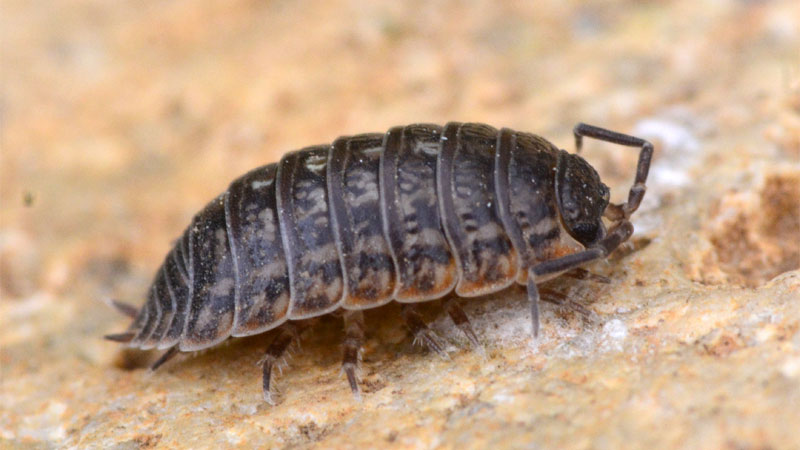
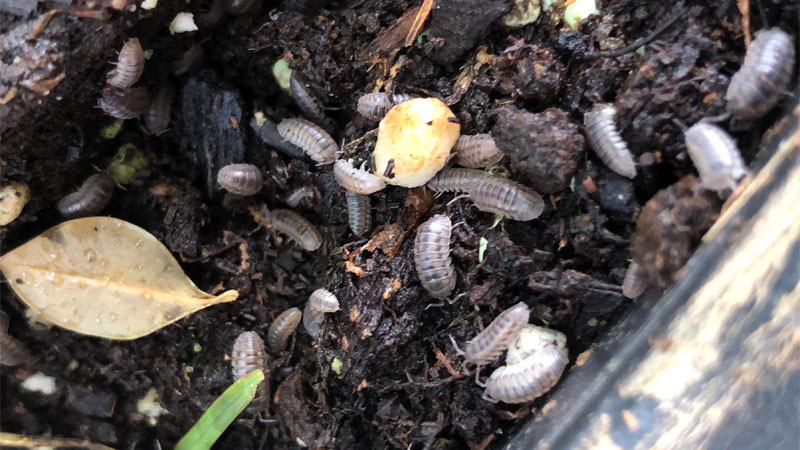
Is Diatomaceous Earth, safe for the vegetation?
Yes, it’s non toxic and completely safe for plants (and around children or pets).
Do you recommend any products to prevent entry into home? I don’t have any water damage and have a dehumidifier in the basement. Seems like they just come in under doors and die inside. I’ve sprayed home defense insecticide but it doesn’t seem to bother these guys.
I’m infested with these ‘guys’ in one of our highway outposts. Ortho ‘home defense” has had little effect.
While I understand that they’re harmless, it’s simply annoying to come into work on a Monday morning and have to sweep up 30 dead ‘potato bugs’ off of the bathroom floor.
What treatment can be done outside of the facility to prevent the intrusion (and certain death) of these bugs?
(Again, they’re usually dead on Monday mornings). And as important as they are to the ecosystem, i don’t want to kill them unnecessarily. Im simply looking for a way to keep them from entering (and dying) in our outposts.
Thanks in advanced for your advice!
Depending on whether you can get permission to do so, I would suggest building a barrier around the foundation. Traditionally, these were panels of corrugated metal driven a foot or two into the ground flush with the foundation that extended slightly above the foundation level. These barriers are a pain, but they help against a number of critters and (if I’m not mistaken) can be purchased in various materials.
Alternatively (and generally easier to do), you could pay close attention to where these mini armadillos are coming in. You could even get a cheap video camera, set it for a low framerate, and monitor the bathroom overnight to try and see where they’re entering if you can’t find entry points during a visual inspection. Once you know where they’re coming in, you can easily seal those entry points using caulk.
I have a small backyard vegetable garden. It is infested with pill bugs. For many years I have grown green beans with success, but last year every shoot was covered in pill bugs as soon as it emerged from the ground. Can I rototill Diatomaceous earth into the garden before planting?
I don’t think it will hurt, but you will need to reapply once a week – more if it rains.
My garden is the same this year. Here’s what I tried and it seems to be working. I have captioned a lot of them. In areas where you see the most of them, insert a cup into the soil so the top lip is level with the soil. Add beer to the cup. As the critters walk over to get some, they fall into the cup and die. I have done this for the last 7 nights. I see a lot less but still nervous to put any seeds in just yet. I hope this helps.
As I understand it, diatomaceous earth needs to be dry to be effective, as the ‘cutting’ edge of the dried microscopic diatom pieces are sharp, which is why they kill the sow bugs upon ingestion. If you have worms I would suggest Neem oil & water diluted spray, which will not harm worms. Neem is a little stinky, but given the nuisance an overabundance of sow bugs can cause may actually smell good. :>
Africans mix D earth in soapy water and pour it down ant holes. It does not dissolve but it gets carried farther I to the nest. I use it in my chicken coop. This stuff is a miracle product. Safe for pets and humans.
I cannot find the product you mention. Can you give more specifics (link, more info)? Thanks!
Diatomaceous Earth (example)
I have them invested in all my flower beds never had them before that I noticed – but now when I go to dig they are all over the plants roots and in the soil. I use DE but I don’t want to kill worms they help the soil. But they are killing my plants along with a huge uptick in moles now.
i live in an apartment building level one..i have the end apartment and exit to outside. since i live on the first floor, this bugs wonder on the hallway n exit entry.. i have to sweep them up every weekend n sweep them outside because i dont want to kill them with a bug spray. what are your recommendations?
Pill bugs are attracted to moisture and decay so make sure they don’t have reason to be where they shouldn’t. A good insecticide (like this or this) would do the job but if you are opposed to that, you can try the old trick to kill slugs/snails.
Fill a shallow dish with a bit of beer. They will be attracted to it and likely drown. You will need to repeat this every few days though and you may need something to act as a ramp to get them inside the container.
Once I capture the pill bugs then what do I do with them? How do I dispose of them?
If you have a compost pile or bin, stick them in there. They’ll speed up the compost process. Otherwise, you can move them somewhere away from your garden or house.
Does putting sand around the outside of the house work
It would definitely help as pill bugs prefer damp environments with organic matter. If you were to put a line of sand in front of a pill bug, it would try to find a way around it but would not cross. But it would only take a small opening for them to get through.
Since I don’t drink beer what can I use as an alternative… Apple cider vinegar or what??
I haven’t heard of ACV working on pill bugs but cornmeal is a good alternative. Simply place a couple tablespoons of cornmeal in a covered plastic container with a small hole at the bottom (old tupperware works well) for the pill bugs to enter. Cornmeal attracts them then kills them after digestion.
I live in Utah. Utah is in a drought. Dry as a bone…yet my garage, also very dry is filled with dead rolly poly bugs…er, crustaceans! What can I spray in my garage to discourage them from coming in?
Your garage is likely going to be slightly more humid and cooler and darker. Make sure you seal any possible entry points when the garage door(s) and man door are closed. There’s probably some dirt or mulch up against the exterior of the garage where they are getting in. Also, you can sprinkle some Diatomaceous Earth (example) along the inside perimeter of the garage to prevent them from crossing the “line”.
I’m in the EXACT same situation and it’s beyond a nuisance anymore.
I moved into a first floor apartment in November of 2023 & I’ve had these bugs coming out of my carpet around the edges & the bug man came & sprayed which did not help at all . These bugs look exactly like the roly poly’s & they drive myself & my dog crazy . What can I do to get rid of them so I can sleep at night without having to worry they will crawl on me? Thank you
Move to a different apartment, in the same complex. ,second floor.
I don’t have a reply for Karla but I would like to suggest to be careful when handling diatomaceous earth. It is sharp crustacean shells and can easily get into your lungs by inhalation. I used to grow organically and while the items are natural they can be dangerous. Just read up about what you use. I had a friend who used composted manure and applied it with bare hands. She ended up in the hospital with an infection in her heart
I mix some Dawn and water in a sprayer then spray every one I see.
It will kill most sprayed. A very laboriously intensive method but it can work.
It can sometimes take 1/2 hour to see one die.
I assume that the water has to evaporate out of the mix so their ‘gills’ become clogged.